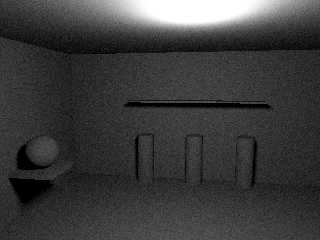 |
 |
|
 |
|
 |
|  |
|  |
|
 |
|
 |
|  |
|  |
|
 |
Last night I got bored, so I made this for the hell of it. There's no
point light sources *and* no radiosity; it's all done with blurred
reflection (10k samples!). Some pp was done in Photoshop to brighten the pic.
Things that would improve the pic:
- lower adc_bailout (I had it set to 1/32 to speed rendering, but it
doesn't give good results in shadowed areas)
- more samples
- higher resolution
- Kari's dynamic range tweaking
- not using such a lameassed technique ;)
Many of these would be feasible on a faster computer, however.
Took about 7 1/2 hours and 100k (!) of memory.
-Xplo
Post a reply to this message
Attachments:
Download 'fakerad.gif' (52 KB)
Preview of image 'fakerad.gif'

|
 |
|  |
|  |
|
 |
|
 |
|  |
|  |
|
 |
Interesting trick, the image reminds me of my night vision, when it is to
dark to see color. I would like to see a second version.
Did you output at 16bit per RGB? I looks like a typical HDRI that needs
16bit or more per channel.
One PP trick I use, I call "soft shadow masked level correction".
Copy the image into the selection channel and blur it ( experience will
tell you how much you need for any given image ) then use this soft self
selection to bring down the highlights a little. Invert the selection and
then bring up the shadows a little. I do this using the grey slider in the
levels menu on GIMP or PS, so that I leave the true white and black levels
where they are. Then convert to 8bit per channel for JPG save.
It would be interesting to see if your trick image could be used in PP to
add a little more realism or complexity to a "normal" render's luminance
values.
Xplo Eristotle wrote:
> Last night I got bored, so I made this for the hell of it. There's no
> point light sources *and* no radiosity; it's all done with blurred
> reflection (10k samples!). Some pp was done in Photoshop to brighten the
> pic.
>
> Things that would improve the pic:
>
> - lower adc_bailout (I had it set to 1/32 to speed rendering, but it
> doesn't give good results in shadowed areas)
> - more samples
> - higher resolution
> - Kari's dynamic range tweaking
> - not using such a lameassed technique ;)
>
> Many of these would be feasible on a faster computer, however.
>
> Took about 7 1/2 hours and 100k (!) of memory.
>
> -Xplo
Post a reply to this message
|
 |
|  |
|  |
|
 |
|
 |
|  |
|  |
|
 |
Daniel Matthews wrote:
>
> Interesting trick, the image reminds me of my night vision, when it is to
> dark to see color. I would like to see a second version.
> Did you output at 16bit per RGB?
No, my copy of Photoshop is old (v. 4, for memory reasons) and barely
acknowledges 16-bit channels. If not for that, I might have done so. The
lighting would have come out better that way.
> It would be interesting to see if your trick image could be used in PP to
> add a little more realism or complexity to a "normal" render's luminance
> values.
It could just as easily be generated with radiosity and/or even an area
light (and the latter would probably be far faster). The only reason I
did it was just for the hell of it, not because it's particularly useful
or efficient. ;)
-Xplo
Post a reply to this message
|
 |
|  |
|  |
|
 |
|
 |
|  |
|
 |




![]()